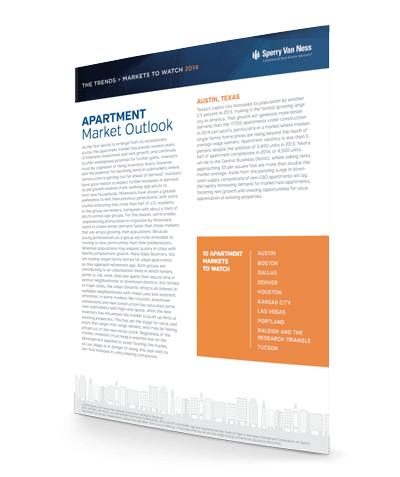Multifamily Market Outlook
Apartments’ Exceptional Resilience
 Flouting expectations that new supply would slow the pace of rent gains, the apartment sector over the last year has shown exceptional staying power. Strong rental demand, particularly amongst Millennials, has allowed most markets to absorb new supply without significant disruption to growth in property income. As of the first quarter of 2015, national rent growth and occupancy rates were near their cyclical highs. The former has actually accelerated, with year-over-year increases in asking rents hitting 3.8% in 2014 and 4% on a seasonally adjusted annualized basis in the first quarter.
Flouting expectations that new supply would slow the pace of rent gains, the apartment sector over the last year has shown exceptional staying power. Strong rental demand, particularly amongst Millennials, has allowed most markets to absorb new supply without significant disruption to growth in property income. As of the first quarter of 2015, national rent growth and occupancy rates were near their cyclical highs. The former has actually accelerated, with year-over-year increases in asking rents hitting 3.8% in 2014 and 4% on a seasonally adjusted annualized basis in the first quarter.
The view that the apartment sector is benefiting from a fundamental change in how young Americans think about homeownership has factored into investors’ readiness to bid aggressively on core and non-core properties. Prices have surpassed their historic highs, lifted by apartments’ favorable risk profile and an abundance of low-cost debt and equity. Across all markets, the national average cap rate declined to 5.5% in 2014. Debt yields have also fallen to approximately 8% as borrowers assume more debt. Life companies, banks, conduit lenders, and specialty lenders are all competing on price and structure with the venerable agencies—Fannie Mae and Freddie Mac—that account for the largest share of all multifamily financing.
Investors are rightfully enthusiastic about the long-term return profile of the apartment sector but they should also be cautious in evaluating the current investment climate. Over the next year, some of the underlying conditions that have defined post-recession apartment investing are set to change. At least on the margins, older Millennials will revisit opportunities for homeownership as housing markets stabilize further. In particular for those that start families, the appeal of the suburbs will grow: in the hierarchy of amenities, new parents may find that a good elementary school will suddenly matter as much as anything on offer in the urban core.
 Apart from the demographic of cyclical factors that may influence household preferences for renting or owning, there are other risks to the apartment sector that must be considered carefully. Most obvious is the challenge of new supply. While the national numbers (and recent history) point to a level of new inventory that may be absorbed in stride, some markets will inevitably overbuild. In some markets, rent slow-downs have been concentrated in downtowns, reflecting the concentration of new development in a tight geographic area. Where the outlook for income growth is more measured, properties may also exhibit greater sensitivity to eventual changes in the interest rate environment.
Apart from the demographic of cyclical factors that may influence household preferences for renting or owning, there are other risks to the apartment sector that must be considered carefully. Most obvious is the challenge of new supply. While the national numbers (and recent history) point to a level of new inventory that may be absorbed in stride, some markets will inevitably overbuild. In some markets, rent slow-downs have been concentrated in downtowns, reflecting the concentration of new development in a tight geographic area. Where the outlook for income growth is more measured, properties may also exhibit greater sensitivity to eventual changes in the interest rate environment.
Multifamily Market Statistics in 2015
Construction activity in the apartment sector continued to climb throughout 2014. Measured in terms of dollar spending, multifamily development activity reached $43.5 billion last year, up from $32.2 billion in 2013, and a low of just $14.7 billion in 2010. Though the year-over-year pace of increases in spending have slowed, there is still exceptional momentum in new development. Recent completions offer an incomplete gauge of the market’s capacity to absorb new space. As of the first quarter of 2015, units currently under construction are approaching their highest levels in thirty years, since the mid-1980s. The largest development pipelines are in the Texas market, including Austin, Dallas, and Houston, and in New York and Washington, DC. Relative to market size, however, Denver and Seattle will have to absorb their fare share as well.


After slowing to a still-impressive pace of 3.5% in 2013, asking rent growth jumped to 3.8% in 2014 and has kept to a strong seasonally adjusted pace in the first quarter of 2015. Market observers had expected that new supply would push both occupancy rates and rent growth slightly lower, but those projections have not proved out. With most markets running at occupancy rates above their long-term averages, concessions have virtually disappeared, with the result that effective and asking rents are not significantly different. The leading markets for rent growth in the first quarter included in Denver, New York, San Francisco, San Jose, and Seattle. Notably absent from the top of the league tables, rent growth is now lagging in Boston and Washington, DC, one of the few gateway or primary markets to see fundamentals falter on the wave of new supply.


Measured across the breadth of small suburban garden apartments at one extreme and the largest urban high-rise properties at the other, multifamily cap rates declined to a national average of 5.5% in 2014. Cap rates fell another 10 basis points to 5.4% in the first quarter of 2015, within range of their all-time lows. Cap rates in the most contested markets, including New York and San Francisco, are now typically in the range of 4% to 5%.
Investors have expressed concerns about a possible bubble in the apartment market, but that has not dissuaded buyers from pushing transaction volume to new highs. In spite of wider-than-average spreads, investors are girding for an increase in interest rates that will exert drags on value. The stronger the prospects for income growth, the more resilient properties should be in the face of higher costs of capital.


Market Cap Rates
Value-weighted national average apartment cap rates fell to 5.5% in 2014, marginally lower than a year before. Market average cap rates ranged from below 5% in selected gateways and primary markets to above 6% in secondary markets and markets where transaction activity was dominated by suburban garden apartment properties. The lowest cap rates were recorded in New York City, principally in Manhattan and the Brooklyn and Queens waterfronts, where investment demand from domestic and cross-border buyers has pushed asset prices to record-highs. Detroit was the only major market to register an average cap rate above 7% in 2014.
It’s a different world out there.
It requires a different kind of commercial real estate firm working on your behalf in order to be successful. The Lipsey Company has ranked the Sperry Van Ness® organization as one of the most recognized commercial real estate brands in the US for a reason — we know how to deliver a certainty of execution for our clients. Sperry Van Ness International Corporation is one of the largest commercial real estate franchisors, with more than 190 locations in 500+ markets.
To download the full 2015 Multifamily Market Outlook report, click here.

 Nashville, Tenn., SVN | AVAT Realty, LLC, one of the nation’s premier net lease brokerage firms, has completed the sale of Millwood Manor, a 200-unit multifamily development in Nashville, Tenn. Andrew Agee, Senior Advisor of SVN | AVAT Realty, LLC brokered the sale of the 201,850 square-foot property for $13.45 million.
Nashville, Tenn., SVN | AVAT Realty, LLC, one of the nation’s premier net lease brokerage firms, has completed the sale of Millwood Manor, a 200-unit multifamily development in Nashville, Tenn. Andrew Agee, Senior Advisor of SVN | AVAT Realty, LLC brokered the sale of the 201,850 square-foot property for $13.45 million. Santa Monica, CA (October 11, 2017) SVN | Rich Investment Real Estate Partners, one of the nation’s premier commercial real estate firms, brokered the sale of 153 San Vicente Boulevard, a 30-unit, 44,199-square-foot multifamily development located on over 21,000 square feet of land in Santa Monica, CA for $23.8 million. Shiva Monify of SVN | Rich Investment Real Estate Partners, one of the firm’s top producers, advised on the transaction.
Santa Monica, CA (October 11, 2017) SVN | Rich Investment Real Estate Partners, one of the nation’s premier commercial real estate firms, brokered the sale of 153 San Vicente Boulevard, a 30-unit, 44,199-square-foot multifamily development located on over 21,000 square feet of land in Santa Monica, CA for $23.8 million. Shiva Monify of SVN | Rich Investment Real Estate Partners, one of the firm’s top producers, advised on the transaction. Tampa has recovered significantly after experiencing deep impacts from the recession and is now growing jobs at an annualized pace of 3.6% with an unemployment rate of 4.8% as of January ‘16, according to the Bureau of Labor Statistics. Job growth also helped sustain population growth of 6.8% from 2010 to 2014, according to the Census Bureau. This growth has caused the multifamily sector in Tampa to expand with growing rents, falling occupancies, and lots of new supply. 2016 should bring approximately 5% rent growth with stable occupancy levels. The city is approximately 50% rental housing based and should demand more units as economic expansion continues. Top sectors for employment growth include Construction, Professional and Business Services, Leisure and Hospitality, and Financial Activities which have annualized growth rates of 7.1%, 7.1%, 6.6%, 3.4%, respectively.
Tampa has recovered significantly after experiencing deep impacts from the recession and is now growing jobs at an annualized pace of 3.6% with an unemployment rate of 4.8% as of January ‘16, according to the Bureau of Labor Statistics. Job growth also helped sustain population growth of 6.8% from 2010 to 2014, according to the Census Bureau. This growth has caused the multifamily sector in Tampa to expand with growing rents, falling occupancies, and lots of new supply. 2016 should bring approximately 5% rent growth with stable occupancy levels. The city is approximately 50% rental housing based and should demand more units as economic expansion continues. Top sectors for employment growth include Construction, Professional and Business Services, Leisure and Hospitality, and Financial Activities which have annualized growth rates of 7.1%, 7.1%, 6.6%, 3.4%, respectively. Seattle is one of the fastest growing cities on the West Coast, with a population that grew 9.8% from 2010 to 2014, according the Census Bureau. Job growth continues at an annualized pace of 3.0% while unemployment has been stable with the latest reading in January ‘16 of 5.6%, according to the Bureau of Labor Statistics. Seattle is an expensive city to live in and as such approximately 54% of the housing units are rentals, according to the Census Bureau. The need for ample housing is real and multifamily assets should perform well for 2016 and beyond. Rents are expected grow over 5% as new supply hits record highs to fill new demand. The best sectors for job creation include Information, Leisure and Hospitality, Trade, Transportation, and Utilities, and Financial Activities, which are growing at 8.1%, 5.0%, 4.2%, and 4.1% annualized rates, respectively.
Seattle is one of the fastest growing cities on the West Coast, with a population that grew 9.8% from 2010 to 2014, according the Census Bureau. Job growth continues at an annualized pace of 3.0% while unemployment has been stable with the latest reading in January ‘16 of 5.6%, according to the Bureau of Labor Statistics. Seattle is an expensive city to live in and as such approximately 54% of the housing units are rentals, according to the Census Bureau. The need for ample housing is real and multifamily assets should perform well for 2016 and beyond. Rents are expected grow over 5% as new supply hits record highs to fill new demand. The best sectors for job creation include Information, Leisure and Hospitality, Trade, Transportation, and Utilities, and Financial Activities, which are growing at 8.1%, 5.0%, 4.2%, and 4.1% annualized rates, respectively.
 San Jose is one of the hottest cities in the Bay Area and thus has experienced very strong employment growth since 2011 which has brought the unemployment rate down to 3.9% as of January ‘16 while jobs are still being created at the robust pace of 3.8% annualized according to the Bureau of Labor Statistics. Population growth is also significant at 6.6% from 2010 to 2014 as people find this market relatively more affordable. The San Jose housing stock is traditionally owner oriented with only 43% used for rentals. Given the rate of regional growth, local multifamily assets are very well positioned to pick up demand from surrounding areas a well as localized growth. Rent growth is expected to exceed 5% with relatively low new supply in 2016. Top sectors in job creation include Construction, Information, and Professional and Business Services with annualized growth rates of 10.3%, 8.4%, and 6.8%, respectively.
San Jose is one of the hottest cities in the Bay Area and thus has experienced very strong employment growth since 2011 which has brought the unemployment rate down to 3.9% as of January ‘16 while jobs are still being created at the robust pace of 3.8% annualized according to the Bureau of Labor Statistics. Population growth is also significant at 6.6% from 2010 to 2014 as people find this market relatively more affordable. The San Jose housing stock is traditionally owner oriented with only 43% used for rentals. Given the rate of regional growth, local multifamily assets are very well positioned to pick up demand from surrounding areas a well as localized growth. Rent growth is expected to exceed 5% with relatively low new supply in 2016. Top sectors in job creation include Construction, Information, and Professional and Business Services with annualized growth rates of 10.3%, 8.4%, and 6.8%, respectively. Reno is experiencing sustained gains in employment with a 4.4% annualized rate after being severely impacted by the past recession; unemployment has improved dramatically and now sits at a still relatively high 6.2% as of January ‘16, according to the Bureau of Labor Statistics. Population has grown robustly with a 4.9% increase from 2010 to 2014, according to the Census Bureau. As is common with tourist market economies, the percentage of city housing used for rental purposes is high at 53% meaning that job growth will quickly mean growth for the multifamily sector. The city’s economy is rapidly diversifying with the biggest gains coming from Construction, Professional and Business Services, Financial Activities, and Education and Health Services with annualized growth rates of 9.6%, 9.5%, 5.2%, and 5.0%, respectively.
Reno is experiencing sustained gains in employment with a 4.4% annualized rate after being severely impacted by the past recession; unemployment has improved dramatically and now sits at a still relatively high 6.2% as of January ‘16, according to the Bureau of Labor Statistics. Population has grown robustly with a 4.9% increase from 2010 to 2014, according to the Census Bureau. As is common with tourist market economies, the percentage of city housing used for rental purposes is high at 53% meaning that job growth will quickly mean growth for the multifamily sector. The city’s economy is rapidly diversifying with the biggest gains coming from Construction, Professional and Business Services, Financial Activities, and Education and Health Services with annualized growth rates of 9.6%, 9.5%, 5.2%, and 5.0%, respectively. Portland has experienced rapid employment growth in 2015, bringing the unemployment rate down to 4.7% as of January ‘16 while sustaining new job creation at a rate of 3.1%, according to the Bureau of Labor Statistics. Population in the city grew by 6.1% between 2010 and 2014 according to the Census Bureau who also reports that approximately 47% of the housing stock is used for rentals. Portland is a relatively high priced market for the nation but still affordable for a major West Coast metro with an excellent quality of life. Leading employment sectors include Information, Leisure and Hospitality, and Education and Health Services growing at 9.4%, 4.6%, and 4.5% respective annualized rates. These dynamics should lead to strong performance of the multifamily sector in 2016 and beyond with rents growing over 10% this year as new supply remains relatively moderate.
Portland has experienced rapid employment growth in 2015, bringing the unemployment rate down to 4.7% as of January ‘16 while sustaining new job creation at a rate of 3.1%, according to the Bureau of Labor Statistics. Population in the city grew by 6.1% between 2010 and 2014 according to the Census Bureau who also reports that approximately 47% of the housing stock is used for rentals. Portland is a relatively high priced market for the nation but still affordable for a major West Coast metro with an excellent quality of life. Leading employment sectors include Information, Leisure and Hospitality, and Education and Health Services growing at 9.4%, 4.6%, and 4.5% respective annualized rates. These dynamics should lead to strong performance of the multifamily sector in 2016 and beyond with rents growing over 10% this year as new supply remains relatively moderate. Phoenix experienced significant gains in overall employment in 2015 that moved the number of jobs significantly above pre-recession peaks as unemployment fell to 4.6% in January ‘16 with continued annualized employment gains of 3.6%. The population grew by 6.2% from 2010 to 2014, according to the Census Bureau, helping to fuel new demand for apartment units. The city utilizes approximately 46% of its housing units as rentals and has relative affordability with high quality of life making the market a prime one to grow in 2016 and beyond, with rents expected to grow over 5% this year. The leading employment sectors are Information, Construction, Financial Activities, Education and Health Services, and Professional and Business Services, growing at annualized rates of 7.6%, 6.3%, 5.3%, 5.2%, and 5.1%, respectively.
Phoenix experienced significant gains in overall employment in 2015 that moved the number of jobs significantly above pre-recession peaks as unemployment fell to 4.6% in January ‘16 with continued annualized employment gains of 3.6%. The population grew by 6.2% from 2010 to 2014, according to the Census Bureau, helping to fuel new demand for apartment units. The city utilizes approximately 46% of its housing units as rentals and has relative affordability with high quality of life making the market a prime one to grow in 2016 and beyond, with rents expected to grow over 5% this year. The leading employment sectors are Information, Construction, Financial Activities, Education and Health Services, and Professional and Business Services, growing at annualized rates of 7.6%, 6.3%, 5.3%, 5.2%, and 5.1%, respectively. Job growth in Philadelphia has brought the city back above pre-recession employment levels as unemployment stays steady at 4.8% as of January ‘16 with modest annualized employment growth of 2.1%, according to the Bureau of Labor Statistics. Population growth has been below the national average as the city only gained 2.2% from 2010 to 2014, according to the Census Bureau. Accordingly, demand for new apartment units is modest compared to other metros of similar size; yet the city does have a relatively high use of housing units as rentals at approximately 47%. Philadelphia does have an advantage in affordability, especially compared with other East Coast metros, and thus has growth potential with rents forecast to grow by over 3% in 2016. The city’s top sectors for job growth include Mining, Logging, and Construction as well as Professional and Business Services where are expanding at annualized rates of 8.2% and 3.7%, respectively.
Job growth in Philadelphia has brought the city back above pre-recession employment levels as unemployment stays steady at 4.8% as of January ‘16 with modest annualized employment growth of 2.1%, according to the Bureau of Labor Statistics. Population growth has been below the national average as the city only gained 2.2% from 2010 to 2014, according to the Census Bureau. Accordingly, demand for new apartment units is modest compared to other metros of similar size; yet the city does have a relatively high use of housing units as rentals at approximately 47%. Philadelphia does have an advantage in affordability, especially compared with other East Coast metros, and thus has growth potential with rents forecast to grow by over 3% in 2016. The city’s top sectors for job growth include Mining, Logging, and Construction as well as Professional and Business Services where are expanding at annualized rates of 8.2% and 3.7%, respectively. The multifamily market in Charlotte has experienced strong growth in demand as the city has gained 10.1% in population from 2010 to 2014, according to the Census Bureau. This has been fueled by significant job growth that has set new records substantially above pre-recession peaks, leading the present unemployment rate to sit at 5.3% as of January ‘16 with new job creation occurring at an annualized rate of 2.8%, according to the Bureau of Labor Statistics. Approximately 45% of the city’s housing stock is renter occupied. Thus, a good deal of the new population is likely to demand an apartment. Further, gross rents are below national averages, making Charlotte affordable and capable of seeing meaningful rent growth. New supply has grown approximately 4% in 2015 which will lower rent growth slightly in 2016, but still likely to be robust and above 4%. Many sectors are adding jobs at annualized rates above 4%, including Financial Activities, Professional and Business Services, and Leisure and Hospitality. However, this city does face a unique risk to continued growth from the new “bathroom” law, perceived very negatively by many; this could jeopardize new job growth and thus the market if firms choose to relocate or otherwise curtail operations in the state.
The multifamily market in Charlotte has experienced strong growth in demand as the city has gained 10.1% in population from 2010 to 2014, according to the Census Bureau. This has been fueled by significant job growth that has set new records substantially above pre-recession peaks, leading the present unemployment rate to sit at 5.3% as of January ‘16 with new job creation occurring at an annualized rate of 2.8%, according to the Bureau of Labor Statistics. Approximately 45% of the city’s housing stock is renter occupied. Thus, a good deal of the new population is likely to demand an apartment. Further, gross rents are below national averages, making Charlotte affordable and capable of seeing meaningful rent growth. New supply has grown approximately 4% in 2015 which will lower rent growth slightly in 2016, but still likely to be robust and above 4%. Many sectors are adding jobs at annualized rates above 4%, including Financial Activities, Professional and Business Services, and Leisure and Hospitality. However, this city does face a unique risk to continued growth from the new “bathroom” law, perceived very negatively by many; this could jeopardize new job growth and thus the market if firms choose to relocate or otherwise curtail operations in the state. The Denver multifamily market has experienced significant additions of new supply as its population has grown 10.6% from 2010 to 2014, according to the Census Bureau. Further, the employment market is outstanding with 3.0% unemployment as of January ‘16 and annualized job growth of 2.5%, according to the Bureau of Labor Statistics. Denver features a larger renter population with approximately 50% of its metro’s housing units used for rental purposes; still rental rates are relatively affordable for a metro of its size, giving it room to grow. Top sectors for employment growth include Leisure and Hospitality, Financial Activities, Manufacturing, and Professional and Business Services growing at annualized rates of 6.0%, 3.9%, 3.5%, and 3.2%, respectively. As such, rent growth could hit 7% in 2016.
The Denver multifamily market has experienced significant additions of new supply as its population has grown 10.6% from 2010 to 2014, according to the Census Bureau. Further, the employment market is outstanding with 3.0% unemployment as of January ‘16 and annualized job growth of 2.5%, according to the Bureau of Labor Statistics. Denver features a larger renter population with approximately 50% of its metro’s housing units used for rental purposes; still rental rates are relatively affordable for a metro of its size, giving it room to grow. Top sectors for employment growth include Leisure and Hospitality, Financial Activities, Manufacturing, and Professional and Business Services growing at annualized rates of 6.0%, 3.9%, 3.5%, and 3.2%, respectively. As such, rent growth could hit 7% in 2016. Boston’s economy has experienced significant job growth such that its unemployment rate is now 4.0% as of January ‘16 and new jobs are being created at a 1.4% annualized rate, according to the Bureau of Labor Statistics. Further, population has grown 6.2% from 2010 to 2014, according to the Census Bureau, and has thus significantly increased the demand for rental housing in the metropolitan region. Bostonians are highly predisposed to renting as over 65% of the housing units in the city are rentals according to Census data; thus prolonged population and job growth will place great pressure on rents which could grow over 6% in 2016 and keep occupancies above 97% while new supply is likely to remain less than 2% . The top sectors for job growth include Financial Activities and Education and Health Services which are growing at 3.1% and 2.9% annualized rates, respectively.
Boston’s economy has experienced significant job growth such that its unemployment rate is now 4.0% as of January ‘16 and new jobs are being created at a 1.4% annualized rate, according to the Bureau of Labor Statistics. Further, population has grown 6.2% from 2010 to 2014, according to the Census Bureau, and has thus significantly increased the demand for rental housing in the metropolitan region. Bostonians are highly predisposed to renting as over 65% of the housing units in the city are rentals according to Census data; thus prolonged population and job growth will place great pressure on rents which could grow over 6% in 2016 and keep occupancies above 97% while new supply is likely to remain less than 2% . The top sectors for job growth include Financial Activities and Education and Health Services which are growing at 3.1% and 2.9% annualized rates, respectively.




















































